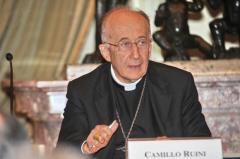Let me introduce you to Mr. Mark Waterinckx, a Belgian who has become known as a critic of the alleged Medjugorje apparitions.
He started out as a great supporter of them, and he was close to the people involved. From 1984 to 1989, his confessor was Fr. Jozo Zovko, who was at times pastor of St. James Church and a spiritual advisor to the visionaries. Mark wrote for Medjugorje magazines, and went to the place 24 times. But things changed.
The other day, Mark summed up the state of the case from his point of view. His article describes the non-believers, the believers, and the fanatics. He tells some history about how the bishops tried to restrain Medjugorje, but were prevented from doing so by the war. He also places the new wave of criticism toward Medjugorje in the context of Pope Benedict's efforts to clean up cases of corruption.
[NB: The headers within the article were added by me for the sake of clarity.]
Now, after that little survey, written with Mark's characteristic bluntness, it's not surprising that he drew fire from some supporters, just as this hit piece.
Such a reaction may be understandable: if some guy took a tough stand against your favorite apparition, why wouldn't you be puzzled at his anger?
Well, there's a reason for it.
Mark Waterinckx was the first man from Belgium to make contact with Medjugorje and has made 24 pilgrimages there since 1984. He has raised thousands and thousands of dollars for Medjugorje. In the summer of 1989 he had become friends with [Fr.] Jozo Zovko [OFM] in Tihalijnawhen an American woman came to him and told him that Zovko had sexually assaulted her. Waterinckx went to Zovko the next day, and Zovko denied everything but was pale and in a terrible state. The incident precipitated a crisis of faith for Waterinckx, who had a conversion experience at San Damiano, which he now doubts. After praying in front of the Blessed Sacrament, Waterinckx decided to walk barefoot to Tihalijna to try to get to the bottom of the matter. When he arrived in Tihalijna, Zovko had regained his composure; he laughed at Waterinckx in spite of the fact that he had severe burns on his feet. Since that time, Zovko has pretended that he doesn't know Waterinckx.
Waterinckx now claims to know 12 women who Zovko has molested including a woman whose father still conducts pilgrimages to Medjugorje, One or two months after his first encounter with the American woman, Waterinckx, seeing that nothing was being done, went to see Leonardo Orec, then curate at Medjugorje. Orec seemed unconcerned about the whole thing. "If you don't do something," Waterinckx told Orec, "I'll go to the provincial in Mostar." Eventually Waterinckx had to write to Herman Schalueck, the Franciscan general, and it was he who finally brought about Zovko's suspension a few months later on August 23, 1989. Rene Laurentin mentioned the suspension in one of his books in '89 adding that the severity of the actions must have indicated that it happened for a good reason. In spite of being suspended, Zovko continued living at Tihalijna. Zrinko Cuvalo, one [of] the Franciscans who was in Medjugorje on day one of the apparitions, was sent to keep an eye on him, but since Cuvalo had a drinking problem the eye was probably not all that observant. Zovko was disciplined a second time in 1994, this time under Bishop Peric for pertinacious disobedience.Waterinckx had had a number of negative experiences which shook his faith beginning in 1986, but the events of 1989, particularly those associated with Jozo Zovko's behavior were so devastating that Waterinckx decided that he had to warn people. However, when he tried to warn people in articles he had written, he suddenly found that his access to the Medjugorje publications which were previously so eager to print what he wrote had been cut off. It was a pattern which would repeat itself over and over again. Only "positive" articles got published. As a result, people were kept in the dark until the truth suddenly overwhelmed their defenses, at which point they became alienated from the Church and disillusioned. Vain credulity was quickly replaced by a general skepticism on the part of people who were having difficulty coping with changes they didn't understand in the first place.
The evidence against Zovko was particularly damning, not only because he had, in effect, created the apparitions by bringing them into the church and thereby conferring on them what seemed to be Church approval, but also because the Blessed Mother herself, at least according to the testimony of Marija Pavlovic on October 21, 1981, had said, "Jozo Zovko is a saint." By March of 1994, Marija had had enough experience with the Franciscans to convince her that Franciscans like Zovko and Vlasic were no saints, but apparently not enough to get her to admit that she wasn't seeing the Gospa. "We must not like only persons like Father Jozo," Marija said in March 1994, "or the seers themselves, since they can become a disillusion [sic] to you. They are not saints." Marija had by then forgotten that she, speaking for the Blessed Mother, had said the exact opposite 13 years before. By the time her caveat of 1994 was made public, Marija Pavlovic had been caught twice in lies involving the two Franciscans who had taken control of the apparitions over the summer of 1981, but by then the Herzegovina Franciscans had shown that they were not interested in the truth -- Father Barbaric had no difficulty inviting the twice-suspended Zovko to attend the International Youth Festival in August of 1997 -- and the pilgrims were too befuddled to know the difference.
(source: E.M. Jones, "The Medjugorje Deception", South Bend, IN, 1998, pp. 164-166. I have corrected a few typographical errors.)
That's reason enough, I'd say.

 The Italian weekly magazine
The Italian weekly magazine 